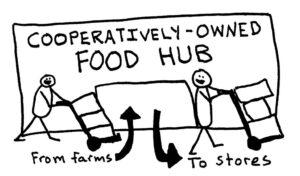Starting a community-based food hub requires dedication, collaboration, and a deep understanding of the needs and preferences of the community you serve.

This Operations & Food Safety Manual provides resources to help you think through how to set up your food hub, from the ground up, including these considerations:
- Assess Community Needs: Understand the specific needs of your community’s vision for food security, and how locally grown food can meet some of those needs. Conduct surveys, interviews, or focus groups to gather insights into what types of food are desired, any existing gaps in availability, and preferences for sourcing. Make sure you are talking to all types of potential stakeholders: farmers, fishermen, value-added food makers, restaurants, individual buyers, and more. Including these voices in your planning is crucial to ensuring buy-in and that folks will use a food hub servce.
- Location: Choose a central and accessible location for your food hub. Consider factors such as proximity to transportation, parking availability, and the demographics of the surrounding community. Costs of the location should also be considered. Many food hubs rent temporary space and share with other like-minded programs.
- Legal and Regulatory Compliance: Understand the legal and regulatory requirements for operating a food hub in your area. This may include obtaining permits, and licenses, and complying with food safety regulations.
- Business Model: Decide on the business model for your food hub. Will it be a nonprofit, for-profit, cooperative, or social enterprise? Consider how you will generate revenue, whether through sales, membership fees, grants, or donations. Diversification of revenue is important to the sustainability of your food hub. Develop a realistic budget, monitor expenses carefully, and explore opportunities for cost-saving measures.
- Infrastructure and Equipment: Determine the infrastructure and equipment needed to operate your food hub efficiently. This may include storage facilities, refrigeration units, transportation vehicles, and packaging materials. This could also be more of a “pop-up” model, using temporary space and shared equipment, keeping your costs lower.
- Marketing and Outreach: Develop a marketing and outreach strategy to raise awareness about your food hub to attract producers and customers. This could involve advertising, social media, community events, and partnerships with local organizations, like a Chamber of Commerce or a Garden Club.
- Community Engagement: Involve the community in developing and operating your food hub by hosting community events like a cooking demonstration, soliciting feedback, and offering opportunities for volunteers. Consider a donation program.
- Evaluation and Adaptation: Regularly evaluate the performance of your food hub and be willing to adapt based on feedback and changing circumstances. This may involve adjusting your product offerings, pricing, or operational processes.
By carefully considering these factors and involving stakeholders in the process, you can create a valuable resource that enhances access to healthy food and strengthens community connections.